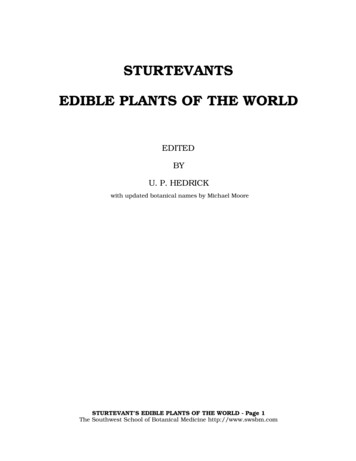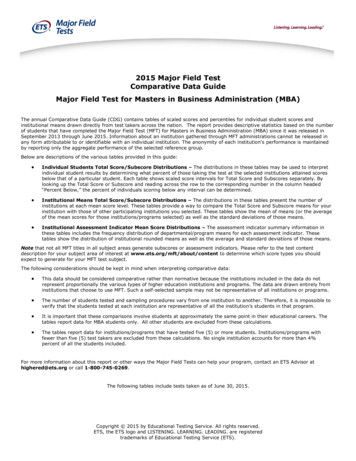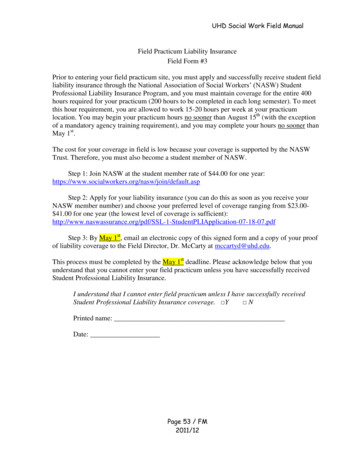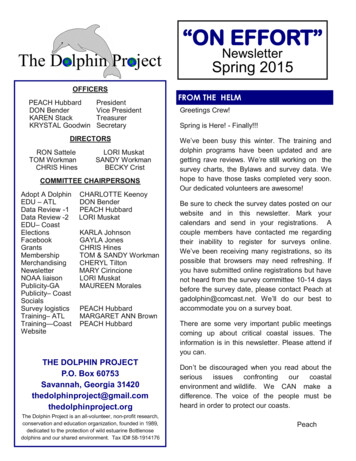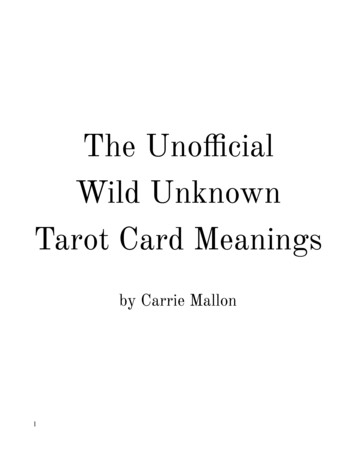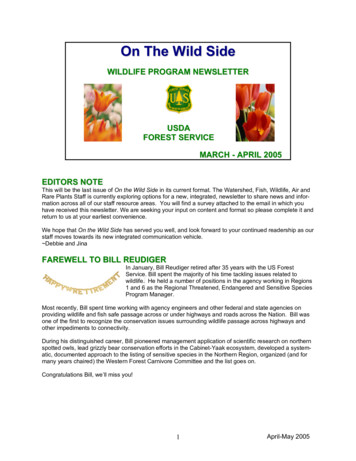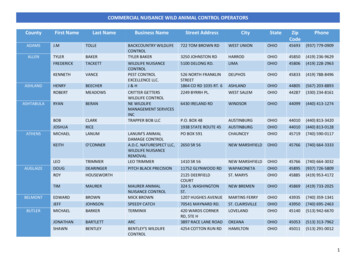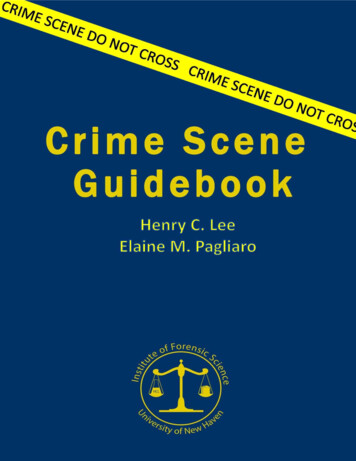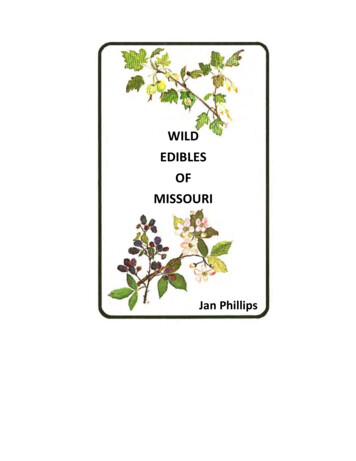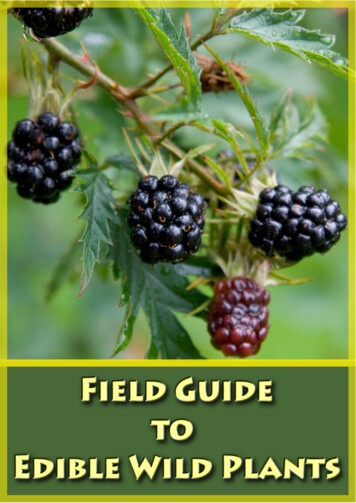
Transcription
Field Guide to Edible Wild Plants1
Field Guide to Edible Wild PlantsContentsGeneral Rules for Your Safety. 3Test The Edibility of the Plants . 5Wild Plants . 6Plants That Are Richest in Protein, Carbs, and Fats . 16Plants Rich in Water . 17Poisonous Plants . 212
Field Guide to Edible Wild PlantsGeneral Rules for Your SafetyThis book is a comprehensive catalog of wild plants, mushroom, and fruit that can beconsumed safely in the wild.Wherever you’re stranded in the wilderness, and you consumed the last food you had,here are some information in case you’re feeling famished. The greenery all around you is theonly option you have because you need to keep up your strength.Some plants are chock full of essential vitamins and minerals while some could makeyou violently ill or even kill you. Much of human nutrition depends to a large extent on cereals, vegetables, and plants: Cereals mainly maize (or corn), wheat, rice, oats, and millet. Grains provide calories in the form of complex carbohydrates such as starch, that areneeded to fuel daily activities. Other staple crops include potatoes, cassava, yams, andlegumes.Human food also includes vegetables, which consist principally of leaves and stemseaten as food.Vegetables are important for the vitamins, minerals, and dietary fiber they supply.Fruits provide a higher quantity of sugars and have a sweeter taste than vegetables.3
Field Guide to Edible Wild PlantsNuts and seeds, including foods such as peanuts, walnuts, almonds, and pistachios,contain unsaturated fats that are also necessary.Many plants are used to flavor foods.Such plants include herbs (e.g. rosemary and mint), which come from the green leafyparts of plants, and spices (e.g. cumin and cinnamon), which come from other plant parts.Some plants produce edible flowers, which may be added to salads or used todecorate foods.Sweeteners such as sugar and stevia are derived from plants. Sugar is obtained mainlyfrom sugar cane and sugar beet, and honey is created when bees regurgitate the nectar fromflowers.Cooking oils and margarine come from maize, soybean, rapeseed, safflower,sunflower, olive and others. Food additives include Arabic gum, guar gum, locust bean gum,starch, and pectin.Plants are also the source of beverages produced either by infusions, such as coffeeand tea; by fermentation, such as beer and wine; or by distillation, such as whiskey, vodka,rum, and other alcoholic spirits.Some of the most common edible plants in the vegetable arena are, potatoes, peas,corn, carrots, squash, and cucumber. Many people opt for fruits, such as, watermelons,tomatoes, peaches, plums, apples, pears, and apricots. Small fruits, such as strawberries,blueberries, and raspberries are easy to find in the wilderness. Some of the most usual herbsinclude basil, thyme, oregano, parsley, and cilantro.Always practice caution while harvesting and eating plants you find along the way.Many careless people have been poisoned from not correctly identifying the plant.An important rule is to eat only a small piece of the wild plant at first and wait 30minutes to an hour to digest. If no side effect has occurred, it can be assumed safe to eat.The location of the plant is important: Beware of plants near waterways, as microscopic parasites could have been washedonto them. Plants near farms could be infected with chemicals.4
Field Guide to Edible Wild Plants Plants near roadways are often coated with pollution.Always take the necessary precautions before eating a plant: Rinse it in clean water. Boil it to kill any possible bacteria. Don’t eat the plant if it smells of almonds. They are almost always poisonous in thewild, as it is a sign of cyanide.Test The Edibility of the PlantsIt is never a good thing to eat plants you cannot identify. There are some methods tosee if an unknown plant is safe to consume: You should be fasting for at least 8 hours. Place part of the plant on your skin to see if there is a reaction. Take a pinch of the plant and touch it to your lips. If no burning or itching develops after 3 minutes, place the plant on your tongue andthen chew it for 15 minutes without swallowing. If no irritation occurs during this period, swallow the plant. Wait 8 hours. Be ready to induce vomiting if any ill effects develop. If everything is fine, consume a quarter-cup of the plant and then wait another 8hours. If there are no ill effects by this point, consider the plant safe to eat.While this book shall provide general guidelines, you should be sure before the use ofany plant in your food that it is, in fact, edible.5
Field Guide to Edible Wild PlantsWild PlantsA little knowledge of plants can save your life.HerbsAsparagus is a vegetable that grows in the wild inmost of the Europe and parts of North Africa, WestAsia, and North America. It’s a great source of source of vitamin C,thiamine, potassium, and vitamin B6. Eat it raw or boil it.Amaranth is an edible weed, native to the Americas, butfound on most continents.You can eat all parts of the plant, but be on the lookoutfor spines that appear on some of the leaves. It’s recommended that you boil the leaves toremove the oxalic acid and nitrates. Don’t drink the water after you boil the plant.Burdock is native to the temperate areas of the Eastern Hemisphere, but you can find it in theWestern Hemisphere as well. It is a medium to large-sized plant with bigleaves and purplish thistle-like flower heads. You can eat the leaves and the peeled stalks ofthe plant either raw or boiled. Remove the bitterness of The leaves by boilingthem twice before eating. The root of the plant can also be peeled, boiled, and eaten.Cattail it is also known as cattail or punk in North America and bulrush and reed mace inEngland. This plant is usually found near the edges of freshwater wetlands. Most of a cattailis edible. You can boil or eat raw the rootstock, or rhizomes, of the plant.6
Field Guide to Edible Wild Plants The rootstock is usually found underground. Makesure to wash off all the mud. The best part of the stem is near the bottom wherethe plant is mainly white. Either boil or eat the stem raw. Boil the leaves. The corn dog-looking female flower spike can bebroken off. It has a corn-like taste.Chickweed is an herb found in temperate and arctic zones.The leaves are pretty hefty, and you’ll often find smallwhite flowers on the plant. They usually appear betweenMay and July. You can eat the leaves raw or boiled. They’re highin vitamins and minerals.Clovers are edible, and you can find them everywherethere’s an open grassy area. You can spot them by their distinctive trefoilleaflets. You can eat clovers raw, but they taste betterboiled.Curled Dock is found in Europe, North America, SouthAmerica, and Australia. It has a long, bright red stalk thatcan reach heights of three feet. You can eat the stalk raw or boiled. Peel off the outer layers first. It’s recommend thatyou boil the leaves with several changes of waterin order to remove its naturally bitter taste.7
Field Guide to Edible Wild PlantsField Pennycress is a weed found in most parts of the world.Its growing season is early spring to late winter. You can eat the seeds and leaves of field pennycressraw or boiled. The only caveat with field pennycress is not to eat itif it’s growing in contaminated soil. Pennycress is a hyper accumulator of minerals, meaning it sucks up all mineralsaround it. Don’t eat pennycress if it’s growing by the side ofthe road or is near a Superfund site.Green Seaweed is found in oceans all over the world. Rinse it with fresh water if available and let it dry. You can eat it raw or include it in a soup.Kelp is another form of seaweed. You can find it in mostparts of the world. Eat it raw or include it in a soup. Kelp is a great source of folate, vitamin K, andlignans.The inner bark of pine trees is edible, and it is availableyear-round. That white spongy layer between the outer barkand the wood is what you want. It is mostly fiber and contains enough carbohydrates Boil this plant into soup.Milkweeds: Several parts are edible with proper preparation.8
Field Guide to Edible Wild PlantsPlantain is found in all regions of the world. You canusually find plantains in wet areas like marshes andbogs, but they’ll also sprout up in alpine zones. Theoval, ribbed, short-stemmed leaves tend to hug theground. The leaves may grow up to about 6″ long and 4″wide. It’s best to eat the leaves when they’re young. Like most plants, the leaves tend to getbitter tasting as they mature. Plantain is very high in vitamin A and calcium.It also provides a bit of vitamin C.Purslane is a small plant with smooth fat leaves thathave a refreshingly sour taste. Purslane grows from thebeginning of summer to the start of fall. It can providemuch needed vitamins and minerals in a wildernesssurvival situation. You can eat purslane raw or boiled. If you’d like to remove the sour taste, boil theleaves before eating.Prickly Pear Cactus grows in the deserts of NorthAmerica and, it is a very tasty and nutritional plant thatcan help you survive. The fruit of the prickly pear cactuslooks like a red or purplish pear. Before eating the plant, carefully remove the small spines on the outer skin. It’s best to boil the stems before eating. You can also eat the young stem of the prickly pear cactus.Sheep Sorrel is native to Europe and Asia but has beennaturalized in North America. It’s a common weed infields, grasslands, and woodlands. It flourishes in highlyacidic soil. Sheep sorrel has a tall, reddish stem and canreach heights of 18 inches.9
Field Guide to Edible Wild Plants Sheep sorrel contains oxalates and shouldn’t be eaten in large quantities. You can eat the leaves raw. They have a nice tart, almost lemony flavor.White Mustard is found in the wild in many parts of theworld. It blooms between February and March. You can eat all parts of the plant — seeds,flowers, and leaves.Edible FlowersEdible flowers are not limited to those which later blossom into fruits and vegetables.Some of the prettiest flowers have petals which we can eat.Specifically, carnations, dandelions, jasmine, rose, lavender, violets, and daisies areedible. Such flowers are perfect to add to a salad, becausethey add sharp color, which always makes a salad moreappealing, along with a delicate flavor.Chicory grows in Europe, North America, and Australia.It’s a bushy plant with small blue, yellow, red or whiteflowers. You can eat the entire plant. Pluck off the young leaves and eat them raw or boil them. The chicory’s roots willbecome tasty after boiling. You can pop the flowers in your mouth for aquick snack.Carnation Separate the petals from the calyx Remove the white base before use as it makeseating them very bitter. It will have a clove-liketaste You can add the petals to salads.10
Field Guide to Edible Wild PlantsDandelion is entire edible — roots, leaves, and flower. Eat the leaves while they’re still young or boilmature leaves to remove their bitter taste. Boil the roots before eating as well. You can drink the water you boiled the roots in asa tea and use the flower as a garnish for dandelionsalad.Fireweed is found primarily in the Northern Hemisphere. You can identify fireweed by itspurple flower and the unique structure of the leaves’ veins; the veins are circular rather thanterminating on the edges of the leaves. It’s best eaten young when the leaves are tender.Mature fireweed plants have tough and bittertasting leaves. You can eat the stalk of the plant as well. The flowers and seeds have a peppery taste. Fireweed is a great source of vitamins A and C.The real Jasmine has tubular white flowers, waxy, andshiny oval leaves.All roses are edible, with the flavor being morepronounced in the darker varieties.Lavender is a member of the mint family. Flowers andleaves can be used fresh, and both buds and stems can beused dried.Most violets are edible, but some yellow species may be slightly cathartic.Daisies are found everywhere on Earth except Antarctica. Its leaves can make a tasty additionto salads (they're closely related to artichoke and are high in Vitamin C).11
Field Guide to Edible Wild PlantsWood Sorrel grows in all parts of the world. Species diversity is particularly rich in SouthAmerica. The leaves are a great source of vitamin C. The roots of the wood sorrel can be boiled. They’re starchy and taste a bit like a potato.There are important rules that absolutely must be followed when using flowers incooking. Establishing if a plant is safe to eat is of utmost importance. Never use an ingredientin your cooking if you are not sure that is safe.Remember that many flowers are poisonous, so be certain of the identity of theflowers you have chosen to cook with. Use only the petals of flowers, as the pollen may cause allergies, and is often bitter. Use small amounts, as any food new to the digestive tract should be introduced slowlyand easily. Try making a salad mix of veggies and fruits, and throw in some flowers as well. Teasare delicious with aromatic flowers.The safest edible flowers are those that will eventually grow into the vegetables andfruits that we already know and love. Often the flowers of vegetables, fruits, and herbs offer areminder of the plant they come from, in a
Plants near farms could be infected with chemicals. Field Guide to Edible Wild Plants 5 Plants near roadways are often coated with pollution. Always take the necessary precautions before eating a plant: Rinse it in clean water. Boil it to kill any possible bacteria. Don’t eat the plant if it smells of almonds. They are almost always poisonous in the wild, as it is a sign of cyanide. Test The .
